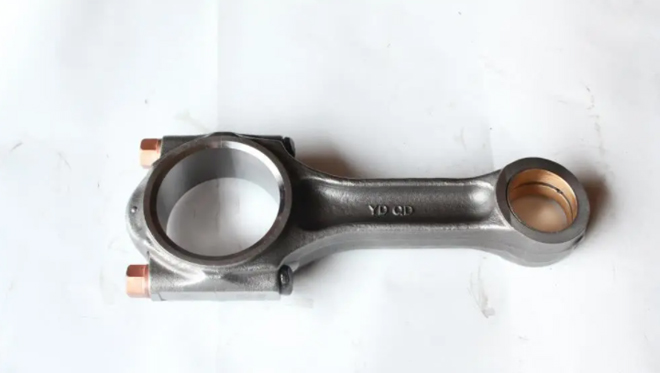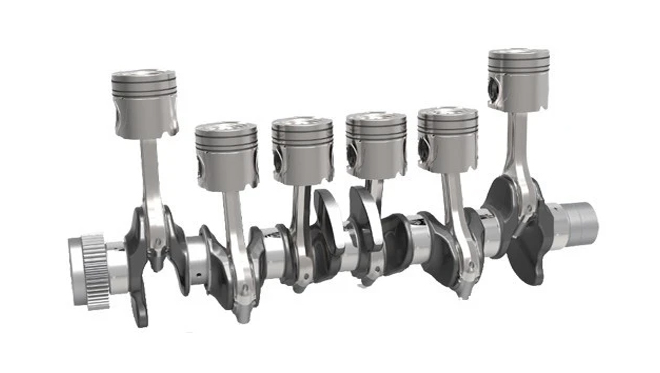2022-01-07 News Views 73817
The damage of connecting rod of diesel engine is seldom seen under normal operation. The shape of the diesel engine connecting rod body is mostly "work" shape, which can meet the strength requirements under normal circumstances. The main reasons for torsion and bending fracture of connecting rod body can be summarized as follows according to practice:

1. If the piston ring is broken or killed in the use of the cylinder, or the gap between the piston and the cylinder wall is too small, as well as poor cooling and other reasons, the piston will be killed in the cylinder. Once the bite cylinder, the movement of the cylinder connecting rod will be blocked, and the other cylinders are still in motion, so that it is subjected to more than the original withstand several times the tension, that is, it is possible to lead to the connecting rod body is bent or broken, the public number of zhicuandawang, bucket and other front-end equipment series.
2. In the process of assembling the diesel engine, if the hole of the fuel injector is not properly protected, the small bolt or washer and other foreign bodies fall into the top of the piston. If not eliminated in time, the diesel engine will not only damage the piston and bending the connecting rod body.
3. When the connecting rod is working, the small head of the connecting rod moves reciprocating with the piston, the big head of the connecting rod rotates with the crankshaft, and the rod body swings under the synthesis of the small head and the big head movement. In addition to the periodic gas impact force, the connecting rod also bears the inertia force of the piston group and the connecting rod. Diesel engine flying accident, will make reciprocating inertia force sharply increased, resulting in connecting rod stress is too large. At this time, if the connecting rod bolt is broken, it must make the connecting rod body twisted and bent fracture under the action of alternating periods of tensile and compressive load at high speed.
4. the so-called hydraulic impact hydraulic impact, is into the diesel engine piston top and into the exhaust pipe of the liquid (such as cooling water, oil, diesel), before starting is not clean, starting into the top of the piston, when the piston upward movement, the connecting rod by the impact of the liquid and bending deformation.
Take the 6110 diesel engine installed in an electric power construction vehicle as an example, if the vehicle is suddenly overturned or rollover accident occurs when working. The whole process takes place in a very short time, and the operator is often too late to extinguish the diesel engine. This is because the diesel injection pump is always full of diesel. As long as the fuel injection pump is in working state, the diesel engine can generally work for 2.3 minutes before flameout and stop running. So when the vehicle overturned or rolled, the diesel engine is still running, the piston is still doing up and down reciprocating movement. At this point, the oil in the oil pan will quickly flow into the cylinder from the gap between the piston and the cylinder wall (piston ring).

At this time the crankshaft is still continuing to rotate, the piston from the bottom dead center upward movement, has been sucked into the cylinder oil, as the piston is gradually squeezed into the combustion chamber. Although the exhaust stroke begins at this point, most of the oil entering the combustion chamber is expelled by the upward piston. But there is still a part of oil left in the combustion chamber, oil as a liquid by its own inertia, its flow rate lags behind the gas flow rate. As the crankshaft continues to rotate, the next cycle of oil enters the cylinder. When the intake stroke into the combustion chamber oil capacity is greater than the combustion volume, to the compression stroke will occur the piston did not reach the top dead center, and the cylinder oil extrusion phenomenon.
The incompressibility of the liquid creates an "oil cushion" that the upward piston cannot overcome. When a cylinder forms such an "oil pad", the piston of the cylinder is suddenly blocked up, which causes an insurmountable moment of resistance to the crankshaft. This resistance moment will cause the piston and crank linkage mechanism to produce strong impact load instantly. When the impact load is less than the strength limit and yield limit of the connecting rod material, the diesel engine will be extinguished by itself. When the impact load is greater than the strength limit and yield limit of the connecting rod material, the connecting rod will be forced to bend and twist.